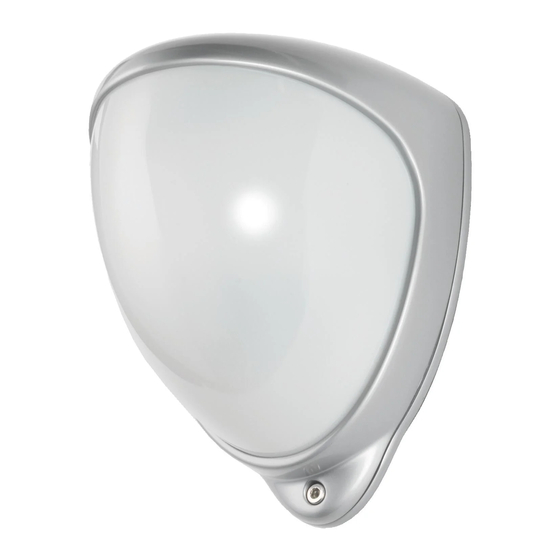
Advertisement
Quick Links
D-TECT DUAL HT
GJD362 High Temperature Technology External
Detector
PACKAGE CONTENTS
•
1 x D-TECT Dual HT
•
1 x Drilling template for fixing holes
•
3 x 31.75mm wall plugs
•
3 x 31.75mm screws
•
2 x Spare Sliding Curtains
•
2 x Tamper Feet
•
1 x Installation manual
INTRODUCTION
The D-TECT Dual HT is an outdoor motion detector and
alarm trigger. Utilising dual detection technology, the Dual
Tech delivers precise, reliable presence detection.
QUICK INSTALLATION
1.
Mount and connect the detector following the
instructions given later in this sheet.
2.
Apply supply voltage to the unit. The detection LED
(blue) flashes three times.
3.
Wait approximately 2 to 3 minutes to allow the
detector to settle.
Note: The front cover must be fitted when walk testing.
The default settings are:
•
Range: 20 meters
•
Pulse count: 1
•
Detection LED: off
MOUNTING THE UNIT
During installation, protect the electronics against water, as
trapped moisture can affect or damage the unit.
WARNING
• NYLON WASHERS PROVIDED MUST BE USED WITH SCREWS
• ENSURE CABLE ENTRY AND SCREW HOLES ARE
SEALED WITH WATER BASED SEALANT
• DO NOT USE SILICONE BASED SEALANT
To reduce the possibility of the microwave circuit being
affected it is recommended to leave a minimum space of 3
metres between D-TECT Dual HT sensors when mounted
alongside each other. When facing each other a minimum
space of 15 metres is recommended.It is possible to
mount the units back to back however when detectors are
mounted in close proximity to one another it is advisable to
carry out a walk test to ensure that external objects are not
influencing the microwave circuit.
1.
Drill the wall to accept the two fixing screws, the
cable entry, and the tamper cup (if used). See
Figures 1 and 2. A hole-drilling template is provided.
Note: We recommend using the tamper cup on uneven
wall surfaces.
2.
Remove the cover assembly by loosening the locking
screw using the allen key provided. The cover hinges
from the top and lifts out of the location slot. See
Figure 3.
3.
Feed standard eight-core alarm cable into the cable
entry. Bare the wires and connect 6 wires to the
terminal block and optionally connect 2 to the tamper
board. See Figures 2, 4, 5, 6 & 7.
4.
Screw the unit to the wall ensuring that the
tamper pin is correctly located and that the tamper
microswitch is closed. See Figure 7. To aid
installation, two spare tamper feet are provided. One
is 1mm longer and the other is 2mm longer than the
tamper foot originally fitted. The tamper foot is a push
fit and can be removed by carefully pulling it from the
pin. See Figure 2.
5.
When the detector is aligned, connected, and
programmed to suit the installation, replace the front
cover and lock as shown. See Figure 8.
MULTIBEAM ALIGNMENT & MASKING
The multifunction lens fitted to D-TECT Dual HT produces
seven long range beams and seven medium to short range
curtain PIR beams. The PIR circuitry detects changes in
heat and movement in the beam pattern; therefore items
such as trees, shrubs, ponds, boiler flues, and animals
should be considered when positioning the detector.
Note: The PIR sensor is more sensitive to movement
across the beams, and less sensitive to movement
directly towards or away from the beams.
The detector module is fitted with two sliding shutters to
reduce the detection angle.
The curtains are fitted to the pan and tilt module as shown
in Figure 9 (shown with primary and additional curtain
sliders fitted). Each section of the detector lens gives a
coverage pattern of approximately 10 degrees.
An additional set of curtain sliders is provided should the
beam pattern need to be narrowed even further, e.g. if the
minimum detection angle of 10 degrees is required.
When coverage exceeds the desired detection area, adjust
the module as required and mask off any beams, either
vertically or horizontally, to avoid unwanted detection.
Use portions of the self-adhesive silver mask applied to the
rear, smooth side of the lens as shown in Figures 10 & 11.
Always replace the lens the correct way up to ensure exact
beam pattern coverage (top of the lens is marked TOP).
Advertisement

Summary of Contents for GJD D-tect Dual HT GJD362
- Page 1 D-TECT DUAL HT GJD362 High Temperature Technology External Detector PACKAGE CONTENTS Feed standard eight-core alarm cable into the cable • 1 x D-TECT Dual HT entry. Bare the wires and connect 6 wires to the • 1 x Drilling template for fixing holes terminal block and optionally connect 2 to the tamper •...
- Page 2 ACCESSORIES the detector module is orientated at an angle of 90° to the GJD is able to supply the following accessories to aid installation: perimeter, the mounting wall may cut off short and medium GJD304 Conduit cable entry adaptor ring range beams.
-
Page 3: Specifications
SPECIFICATIONS Microwave 10 dBm EIRP Frequency Operating frequency (country specific) GJD362/25 - 10.525GHz GJD362/35 - 9.35GHz GJD362/87 - 10.587GHz GJD362/90 - 9.9GHz Detection Area Selectable between 10 & 20 metres. Coverage 10-70 degrees detection angle, 20m x 20m coverage max. Adjustment 180 degree pan + 90 degree tilt. - Page 5 Switches...
- Page 6 ENGINEER NOTES www.gjd.co.uk info@gjd.co.uk +44 (0) 1706 363 998 Unit 2 Birch Business Park, Whittle Lane, Heywood, Greater Manchester, OL10 2SX, UK...















Need help?
Do you have a question about the D-tect Dual HT GJD362 and is the answer not in the manual?
Questions and answers